
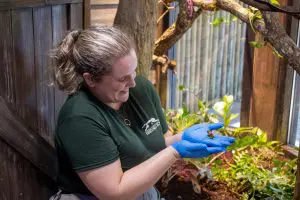
Herps & Aquatics zookeeper Jordan beams at one of the poison dart frogs she works with.
At our Zoo, animal wellbeing is central to our mission—that’s why our animal care team is always going the extra mile to ensure our animals are healthy and thriving!
From rethinking habitats to finetuning training, we strive to share that knowledge as well through research papers or husbandry articles. Read on to learn more about the projects and training our keepers have taken on, and how they’re helping their fellow animal care experts give their own animal residents incredible care.
Poison Dart Frogs
When Jordan Lowery, a keeper on the Herps & Aquatics team, learned we wanted to upgrade our poison dart frogs’ habitat, she began brainstorming. Our more than 15 poison dart frogs call our Rainforest Revealed area’s Venom House home – it’s a dynamic habitat that replicates much of these species’ native ranges, from the temperature to the UV exposure!
At the time, the habitat was made up of sparsely planted mixed plants. She wondered how each of our frogs would react to using plants native to their natural range instead.
“I said, ‘The frogs would prefer native plants.’ My curator replied, ‘Prove it,’” Jordan said.
To test her theory, Jordan divided the habitat in three sections: plants from the same natural range as the poison dart frogs–South and Central America, plants from African and Asian rainforests and a control group of the same mixed plants that were already there.
After recording observational data every hour, she found the frogs were most seen around the densely plants compared to the more sparsely planted areas. Though she needs more research to conclude which region of plants works best for the frogs, it’s safe to say they prefer their new set up!
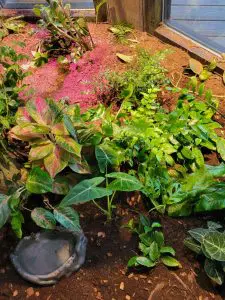
Take a look at the frogs’ freshly planted habitat!
“Knowing which plants they prefer will help us provide better wellbeing for them,” she said. “Planting these plants could allow them to express natural behaviors that they otherwise miss out on.”
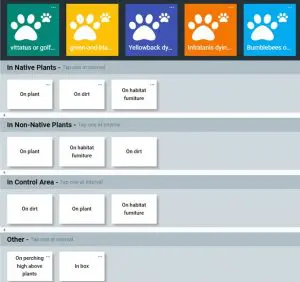
Jordan uses this chart to record where the frogs are spotted and deduce which plants they like best!
Baird’s Tapirs
Ever since Rainforest Revealed keeper Albert Ferraro joined our Zoo, he has gravitated toward our Baird’s tapirs. This includes Mia, Josephine, who has now passed away, and Antonio, who has since moved to another zoo.
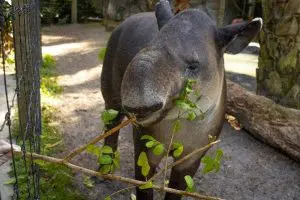
Mia is currently our Zoo’s one and only Baird’s tapir!
The tapirs’ habitat is broken up into three “yards” or living spaces. However, only one of these yards had a dedicated space for training the tapirs for behaviors like targeting, mouth opening, voluntary ultrasounds, blood draws and more.
These highly individualized trainings are vital to the tapirs’ routine care, while also giving them the power of choice and control.
“Allowing them to participate willingly in their own healthcare ensures the animals have as much choice as possible,” he said. “The best thing about the tapir training is that the work we do with them reduces stress for medical procedures and even eliminates the need for sedation.”
Answering the call for more training spaces, Albert added two additional training areas by modifying each of the existing yards. From a hoof trimming station to a spot for blood drawing, each area was designed with different types of training in mind.
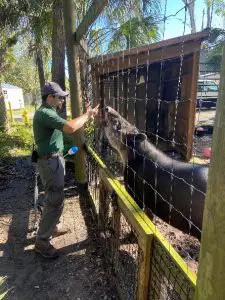
Albert Ferraro trains one of the tapirs in the modified “Tapir C” yard.
Not only did “thinking outside the box” smoothen the training process for keepers, but it expanded the possibilities for training our tapirs!
Reptiles
Reptiles often get a bad rap with many people viewing them as mere sedentary creatures. But if you look closer, they’re quite intelligent and capable of learning, said Nicole Payne, the Herps & Aquatics area supervisor.
In 2019, the team decided to challenge this perception. So, they set out to build new, public-facing training sessions aimed at reshaping how people view reptiles.
“It opens their minds to see beyond the “slimy scaly” persona that media and society have labeled reptiles with for so long,” she said. “Plus, it builds empathy and appreciation for these species, leading to greater interest in conservation.”
Coupled with this opportunity, building a new program meant we could introduce more training centered around husbandry, or the day-to-day care our animal residents receive.
With this new program, our former Komodo Dragon, Sheldon, was taught voluntary nail trimming and body conditioning to improve his weight and muscle tone. This training has and will continue with our new Komodo dragon resident, Ryu.
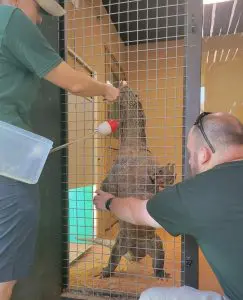
Our Herps & Aquatics team uses targeting to give our Komodo dragon a manicure!
Additionally, our American Alligators, Toothless and Martha, had their open mouth and target training updated to ease the feeding process. And for the first time, voluntary weight checks were introduced. We updated training for our crocodiles to administer injections, too!
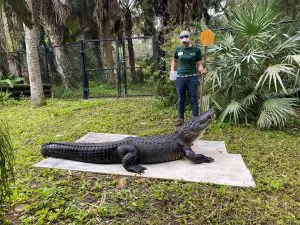
Nicole Payne uses boards for mock scales to gather the alligators’ weights.
Finally, a new targeting system was established for Capone, our alligator snapping turtle, to encourage him to walk on land along with voluntary nail trimming.
With these new changes, our Herps & Aquatics team can better care for our reptilian friends while showing off how smart they really are!
Nicole presented a paper on this research at the American Association of Zookeepers Conference in 2022 to share the benefits of expanding reptile training.
We hope you’ve enjoyed learning more about some of our animal care team’s work! Stay tuned for more innovative ways they ensure our animal residents are living their best lives with us.
Special thanks to Flammio Financial Group, Stifel-Garvin Wealth Management Group, Artemis IT, and Jim and Darleen Barfield. Their generosity makes our work possible!
Brevard Zoo is an independent, not-for-profit organization that receives no recurring government funding for our operating costs. Your generous support enables us to continue to serve our community and continue our vital animal wellness, education and conservation programs.